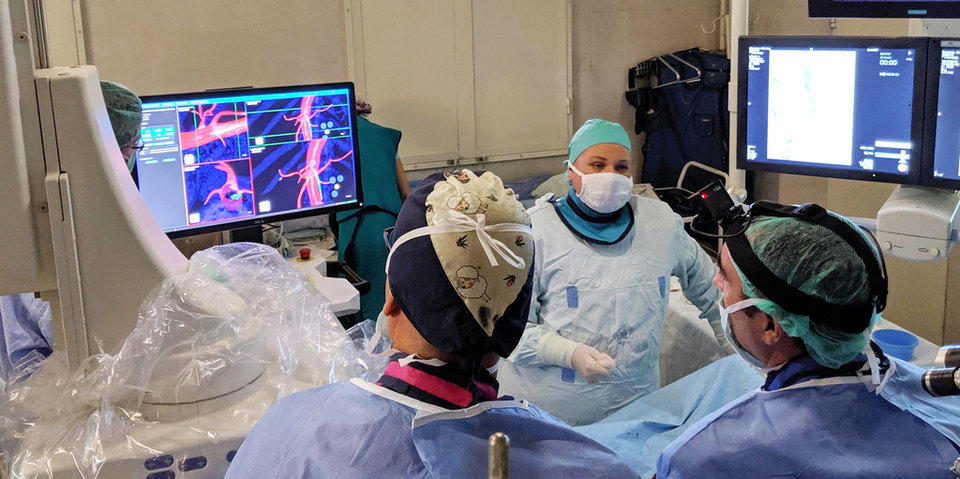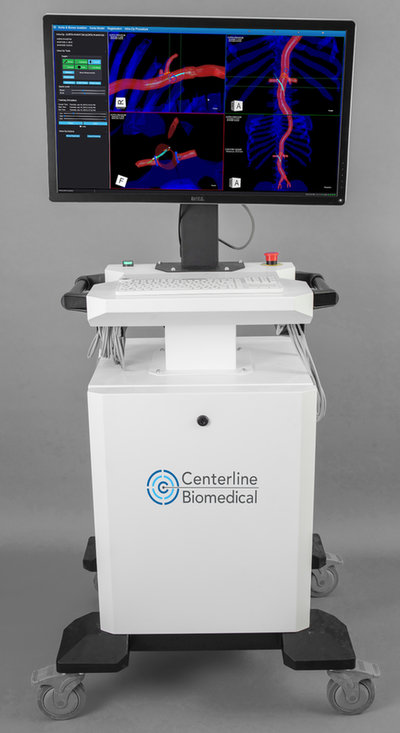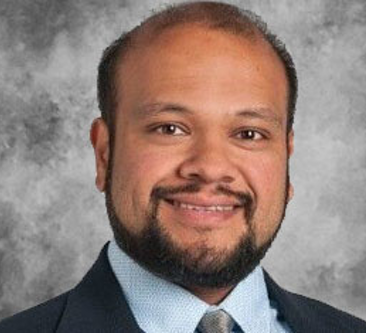Centerline Biomedical
New Horizons in
Endovascular Navigation
For Centerline Biomedical, a spinoff company of Cleveland Clinic, heavy use of 2D radiation-emitting fluoroscopy will soon become a thing of the past. Its revolutionary Intra-Operative Positioning System (IOPS) platform technology, indicated for endovascular interventions in the descending aorta for procedures like endovascular aortic repair (EVAR) to treat aneurysms takes 3D images of the surgical site synchronized with real-time information. This enables physicians to control multiple views, to visualize precisely what they need to see, and navigate catheters and guidewires with confidence and precision – while minimizing the use of radiation and contrast dyes. This first indication will be bolstered with future clinical applications in development.
Using a GPS-like system that provides 3D guidance and an array of mathematical algorithms, IOPS works by improving what interventionalists see as they prepare to perform a minimally invasive procedure. Advanced 3D color visualization brings the patient´s vascular anatomy to life like no traditional 2D grayscale imaging can, enabling physicians to follow the position of instruments inside it, adjust them into the most exacting positioning in real time, and operate with far greater precision. In effect, it provides visualization of both the native anatomy and the surgical tools.
Centerline´s technology is an improvement over intravascular ultrasound (IVUS) and fusion overlay, other imaging modalities that use enhanced imaging or a catheter with a miniaturized probe attached to its tip. Although the advantage of IVUS compared with other vascular imaging techniques is that it can “see” through blood and soft plaque, where it comes up short is in that it typically only captures a cross section of the vessel, whereas IOPS provides multiple views and the visualization of proprietary catheters and guidewires.
IOPS easily integrates into existing OR and lab workflows by creating a mathematical model of the patient anatomy based on previously collected scan data within minutes and anytime between pre-op CT and patient registration. The system setup involves bringing a wheeled cart into the operating room and attaching the tracking system onto the operating table, followed by attaching a tracking pad to the patient and performing registration. The registration resembles the existing process used for fluoroscopic overlay, but augments the x-ray component with IOPS´ electromagnetic tracking and visualization guide. The company has just begun limit launch of IOPS at key institutions across the US.
“The Centerline IOPS technology is the only electromagnetic, non-radiation emitting system for navigating and positioning sensor-equipped devices in vascular anatomy in real time. No other competitor today has similar technology. We are in a unique position to partner with medical imaging, surgical robotics, consumable and implant device companies and healthcare analytics and data providers to adapt the underlying technology for multiple future applications,” says Philip Rackliffe, the company´s CEO.
IOPS´s value lies not only in rationalizing workflows and improving the physician experience, but also in reducing the risk to both patient and healthcare staff from radiation exposure associated with conventional x-Ray fluoroscopy techniques. x-Ray fluoroscopy is a sequence that fires x-rays from 5-times to 20-times per second and is typically done with the patient lying on a table with several caregivers standing next to it. It has the potential to cause damage to healthy tissue and limits what it lets the physician see.
"About 150 years ago, surgeons never bothered washing their hands. I believe it won't be long before we look back at today— when we routinely irradiated a room full of people just to fix an artery — as similarly barbaric," says Vikash Goel, Centerline´s CTO and founder.
Thanks to its enhanced visualization and navigation powers, IOPS reduces average procedure time by way of improving device placement accuracy (stents and endografts) and lowering the risk for endoleaks, errors, and need for costly re-interventions as well. In turn, by making vascular imaging procedures safer and more efficient, the technology also increases the utilization of operating rooms or cath labs, allowing hospitals to increase revenues while saving patients potential out-of-pocket costs and minimizing payers´ healthcare expenditures.
“Combined with a patented process of converting static images into dynamic anatomical models, this technology transforms the operating room into a dynamic visual and data-driven operation with the tools to optimize clinical success and efficiency,” says Rackliffe.
The idea to create the first and only 3D visualization and real-time navigation system came about when Vikash Goel, Centerline´s Chief Technology Officer, and Karl West, Director of Medical Devices Solutions at the Cleveland Clinic´s Lerner Research Institute, set out to fulfil their mentor Dr. Roy K. Greenberg’s vision of advancing endovascular surgery. In 2014, after years of channelling the hard work and dedication by vascular physicians and researchers at the Cleveland Clinic, IOPS was born with a working prototype and first-in-man data.
In 2018, the surgical navigation start-up received a Small Business Technology Transfer (STTR) award from the National Heart, Lung, and Blood Institute to develop an application that brings that lifelike clarity even closer to a doctor´s field of view. The application intends to use HoloLens, a mixed-reality technology by Microsoft embedded in “smart” glasses that superimposes the visualization from the screen onto the operator´s direct line of vision. In addition, the company has received 3 National Institute of Health (NIH) grants to study new clinical applications.
Fast forward to today, when in addition to facilitating minimally invasive endovascular procedures, the IOPS platform is under development for use in non-aortic procedures and non-vascular markets, such as structural heart and oncological interventions, that are still limited by 2D imaging technologies and their visualization challenges. With a freshly obtained FDA 510(k) clearance to market IOPS for descending aortic interventions, Centerline seems on the right track in betting on a future of cardiovascular surgery that no longer relies on greyscale imaging when real-time 3D color guidance will become the standard of care.
How it works
Efficiency on all fronts
Genesis and road ahead



The Centerline IOPS technology is the only electro-magnetic, non-radiation emitting system for navigating and positioning sensor equipped devices in vascular anatomy in real time. No other competitor today has similar technology. We are in a unique position to partner with medical imaging, surgical robotics, consumable and implant device companies and healthcare analytics and data providers to adapt the underlying technology for multiple future applications.
Philip Rackliffe, CEO, Centerline

About 150 years ago, surgeons never bothered washing their hands. I believe it won't be long before we look back at today— when we routinely irradiated a room full of people just to fix an artery — as similarly barbaric.
Vikash Goel, CTO and founder, Centerline

Centerline Biomedical is setting the tone for what innovations in endovascular procedures will look like in the future. Deploying superb precise 3D visualization with real-time electromagnetic tracking, its current goal is to improve device placement accuracy while reducing x-ray fluoroscopy and contrast dye, with hopes of eventually eliminating both through further development.
By Gergana Koleva